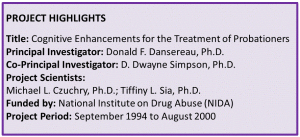Cognitive Enhancements for the Treatment Of Probationers

The focus of the first 5-year phase of the CETOP Project (Cognitive Enhancements for the Treatment of Probationers) was to study the impact of enhancing mandated substance abuse treatment with cognitive/behavioral tools. The Tarrant County Substance Abuse Treatment Facility (SATF) was a 4-month intensive residential treatment program for 420 probationers each year. This facility was located in the Community Correctional Facility in Mansfield, Texas, and shared a physical plant with two other units (a boot camp and a halfway house). Probationers mandated by judges to the SATF spent their 4 months in a small “community” of residents, where counseling was provided daily. The program also offered a variety of educational and life management activities. Standard treatment program components included (1) a modified therapeutic community approach, (2) counseling to provide professional guidance and support in recovery efforts, (3) special induction and transition sessions to plan for treatment, and later, for recovery maintenance, and (4) life skills instruction and recovery education activities.
Core elements of the cognitive enhancement system introduced by this project were TCU (node-link) Mapping, motivational tools, cognitive skills activities, and scripted collaboration. These tools were used independently and interactively to enhance the drug abuse treatment components at the SATF. During-treatment and follow-up assessment measures were used to assess reactions to treatment. The comprehensive battery of measures developed in the DATAR Project was modified for use in this project.
Node-link mapping and associated visual representation strategies were applied to enhance communication and understanding. These visual-graphic techniques were designed as simple methods of eliciting, representing, and organizing information so that relationships between ideas, feelings, and actions can be easily recognized and understood.
Motivational tools were designed to enhance the induction and transition phases of treatment. A series of self-study booklets provided training in the cognitive skills (e.g., decision making, problem solving) that are the “basics” of life skills.
The final element consisted of a set of strategies structured to encourage cooperative activities among probationers. Probationers working together on a specific task were trained to help each other clarify and elicit ideas and feelings, detect “glitches” in thinking, provide emotional support, develop alternative perspectives, and improve decision making. Responses of residents receiving enhanced treatment were compared to those receiving treatment as usual (TAU).
Four sub-studies were conducted. The first three focused on enhancements to counseling, induction/transition, and life skills education, respectively. The overall randomized research design was cumulative in that enhancements developed and tested in each study became a regular part of treatment for all probationers entering the SATF during later studies. The fourth study examined the effectiveness of the enhancements with special populations (e.g., females).
Findings
Mapping. Results showed that residents rated counseling sessions with extensive map use as “deeper” and having greater group participation. Compared to residents who were not in mapping communities, mapping residents gave more favorable ratings to: their counselors; group counseling sessions; their fellow-residents; security staff; their own efforts to benefit from treatment; and their own abilities to benefit from treatment. In addition, mapping residents also reported better progress toward treatment goals, more participation in group sessions, and more positive responses to treatment as a whole. These early studies helped establish the foundation of evidence for “TCU Mapping-Enhanced Counseling.”
Readiness and Reentry (induction into treatment; transition back to society). Residents who received these activities (which included the Tower of Strengths and Downward Spiral) rated their communities as significantly more engaged in treatment and more helpful to them than those receiving the standard treatment. They rated themselves as more involved in treatment and gave higher ratings to the treatment program and personnel. Those with lower levels of educational experience who received the Readiness and Reentry activities rated their confidence and motivation higher than did a similar group in the standard program.
Selected Phase 1 CETOP Publications
Czuchry, M., & Dansereau, D. F. (2003). Cognitive skills training: Impact on drug abuse counseling and readiness for treatment. American Journal of Drug and Alcohol Abuse, 29(1), 1-18. [Abstract]
Czuchry, M., & Dansereau, D. F. (2000). Drug abuse treatment in criminal justice settings: Enhancing community engagement and helpfulness. American Journal of Drug & Alcohol Abuse, 26(4), 537-552. [Abstract]
Sia, T. L., Dansereau, D. F., & Czuchry, M. (2000). Treatment readiness training and probationers’ evaluation of substance abuse treatment in a criminal justice setting. Journal of Substance Abuse Treatment, 19, 459-467. [Abstract]
Blankenship, J., Dansereau, D. F., & Simpson, D. D. (1999). Cognitive enhancements of readiness for corrections-based treatment for drug abuse. The Prison Journal, 79(4), 431-445. [Abstract]
Czuchry, M., & Dansereau, D. F. (1999). Node-link mapping and psychological problems: Perceptions of a residential drug abuse treatment program for probationers. Journal of Substance Abuse Treatment, 17(4), 321-329. [Abstract]
Czuchry, M., Sia, T. L., & Dansereau, D. F. (1999). Preventing alcohol abuse: An examination of the “Downward Spiral” game and educational videos. Journal of Drug Education, 29(4), 323-335. [Abstract]
Newbern, D., Dansereau, D. F., & Pitre, U. (1999). Positive effects on life skills motivation and self-efficacy: Node-link maps in a modified therapeutic community. American Journal of Drug and Alcohol Abuse, 25(3), 407-423. [Abstract]
Czuchry, M., Dansereau, D. F., & Sia, T. L. (1998). Using peer, self-, and counselor ratings to evaluate treatment process. Journal of Psychoactive Drugs, 30(1), 81-87. [Abstract]
Pitre, U., Dansereau, D. F., Newbern, D. & Simpson, D. D. (1998). Residential drug-abuse treatment for probationers: Use of node-link mapping to enhance participation and progress. Journal of Substance Abuse Treatment, 15(6), 535-543. [Abstract]
Newbern, D., Dansereau, D. F., & Dees, S. M. (1997). Node-link mapping in substance abuse: Probationers’ ratings of group counseling. Journal of Offender Rehabilitation, 25(1/2), 83-95. [Abstract]